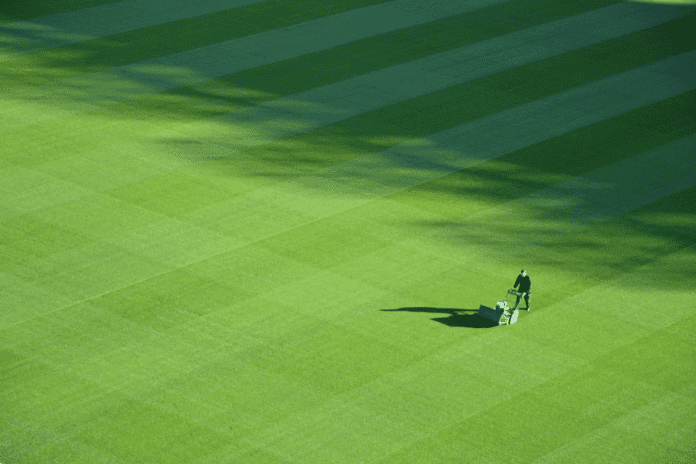The garden power tool experts at Toolstation have teamed up with professional gardener, Thea Pitcher (@theapitcheroutdoorcreations), who has worked on TV gardening shows like Gardeners’ World, to share her top ten lawn maintenance tips.
From advice on how to achieve that “football pitch-like” appearance, to guidance on making your lawn wildlife friendly, here is everything you need for a healthy-looking lawn:
- When to start mowing your lawn
“Once your lawn starts to grow and the weather becomes mild, you can begin mowing. This is generally between March and April. However, don’t leave it too long or the mower will struggle to cut through the long grass, making your job harder. Mow it on a high cut for the first trim of the season as this will avoid causing any distress to the grass by taking too much off at once.”
- How often to mow your lawn
“Depending on how perfect you want your lawn to appear and how fast it’s growing, you should look to cut it once a week or once a fortnight. For a healthy-looking lawn, aim to cut it about 4cm high in spring and autumn, and 2-3cm high during the summer.”
- When not to mow your lawn – to avoid damage
“Avoid mowing when it’s wet as the blades won’t be able to slide through the grass well and lawnmowers can become clogged up. You also should not mow when it’s frosty or if a hard frost is forecast because this can cause damage to the blades. The cold temperatures also make the grass more brittle and prone to breaking.”
- How to revive a damaged lawn
“Sad or damaged lawns can be caused by regular footfall, compacted soil, or drought. The best way to fix this is by aerating the lawn. This means making holes in the lawn to break up the compacted ground and allow water to pass through. It also helps to prevent poor drainage which can lead to moss.
“Lawn aerators can be bought for this, or if you don’t have a big lawn and feel like exercising, you can use a garden fork. Push the fork about 10cm deep and repeat every 10-15 cm.
“Once the aerating is done, rake the lawn and spread grass seed over the top. Then dress with a lawn top dressing (a sandy soil which is spread thinly over the top of the whole lawn). It will help to improve the soil structure and prevent thatch (dead grass build-up). This also helps to keep the lawn level, and can be used to fill in any hollows in the lawn.”
- How to make your lawn wildlife friendly
“If you want to maintain a wildlife-friendly lawn, it’s important to mow less often. Instead of mowing your lawn weekly, consider mowing it once a month. This allows the grass and other plant species such as clover, buttercups, and daisies to grow. These flowering plants provide nectar for pollinators and serve as hiding places for insects.
“Another option is to choose a specific area of your lawn to be left unmown, creating a habitat for wildlife. You can mow a path through this area to walk through the long grass and wildflowers without damaging other sections.”
- How to achieve a perfect striped lawn
“If you want to achieve a football pitch-like lawn with perfect lines and striped patterns, first, you’ll need to buy a lawnmower that has a roller attachment. This roller is essential for creating the desired striped effect.
“Start by mowing around the perimeter of your lawn to establish clear boundaries. Then, cut the rest of the lawn by moving in straight lines, continuing up and down the entire length of the area. The roller will bend the grass blades in different directions, creating the contrasting stripe pattern
“To complete the polished look, pay attention to the edges of your lawn. Regularly cut the edges to maintain a neat and well-defined finish.”
- When to stop mowing your lawn
“Traditionally it was advised you stop mowing for the year around October. However, due to the effects of climate change, the mowing season may carry on until November in some regions of the UK. Basically, if you find your grass is still growing and the weather is mild with no frost forecast, you can keep on mowing!”
- Tips for mowing a difficult lawn
“When mowing sloping lawns, it’s best to mow across the slope, from side to side. This method makes it easier to maintain consistent balance. For steep lawns, hover-type mowers are often the ideal choice.
“If your lawn has uneven terrain with dips or hollows, it’s advised to fill them in before mowing. If filling isn’t feasible, a strimmer would be my preferred tool for the job.”
- Designing a low-maintenance lawn
“The majority of grass seed or turf you can buy consists of a blend of perennial grasses. These types of grasses are known for being durable and low-maintenance, making them resilient to irregular mowing and high-footfall traffic. They are well-suited for lawns that require less maintenance.
“On the other hand, fine grass lawns such as the type you would find on bowling greens or golf courses, require more frequent mowing to maintain their desired appearance. These lawns need regular trimming to ensure they look their best.”
- How to maintain your lawn as a dog owner
“When your dog urinates on the lawn, it can lead to yellow patches caused by nitrogen which burns the grass. This tends to be more of an issue with female dogs who squat to urinate.
“Unfortunately, there’s no quick fix to address this problem. You can use a hose to water the spot where they urinated to dilute the urine and minimise the damage. Or, I have seen some people successfully train their dogs to use a designated area to do their business.”

| [donate]
| Help keep news FREE for our readersSupporting your local community newspaper/online news outlet is crucial now more than ever. If you believe in independent journalism,then consider making a valuable contribution by making a one-time or monthly donation. We operate in rural areas where providing unbiased news can be challenging. |



















